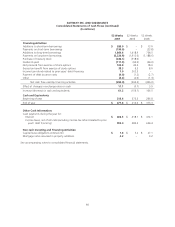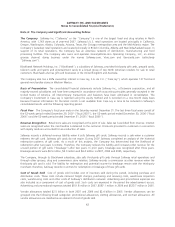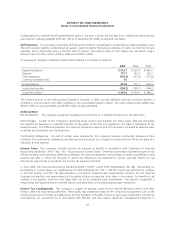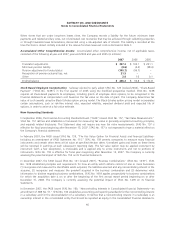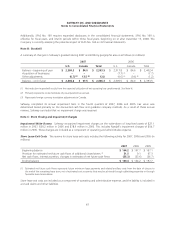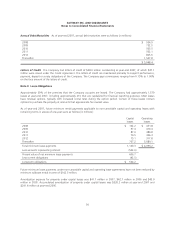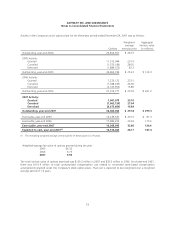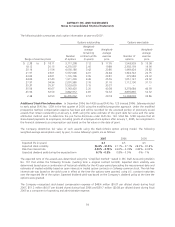Safeway 2007 Annual Report Download - page 67
Download and view the complete annual report
Please find page 67 of the 2007 Safeway annual report below. You can navigate through the pages in the report by either clicking on the pages listed below, or by using the keyword search tool below to find specific information within the annual report.SAFEWAY INC. AND SUBSIDIARIES
Notes to Consolidated Financial Statements
estimating final outcomes. Actual results could materially differ from these estimates and could significantly affect the
Company’s effective tax rate and cash flows in future years.
Off-Balance Sheet Financial Instruments The Company has, from time to time, entered into interest rate swap
agreements to change its portfolio mix of fixed - and floating-rate debt to more desirable levels. Interest rate swap
agreements involve the exchange with a counterparty of fixed - and floating-rate interest payments periodically over the
life of the agreements without exchange of the underlying notional principal amounts. The differential to be paid or
received is recognized over the life of the agreements as an adjustment to interest expense. The Company’s
counterparties have been major financial institutions.
Energy Contracts The Company has entered into contracts to purchase electricity and natural gas at fixed prices for a
portion of its energy needs. Safeway expects to take delivery of the electricity and natural gas in the normal course of
business, and these contracts are not net settled. Since these contracts qualify for the normal purchase exception of SFAS
No. 133, “Accounting for Derivative Instruments and Hedging Activities,” they are not marked to market. Energy
purchased under these contracts is expensed as delivered.
Fair Value of Financial Instruments Generally accepted accounting principles require the disclosure of the fair value
of certain financial instruments, whether or not recognized in the balance sheet, for which it is practicable to estimate fair
value. The Company estimated the fair values presented below using appropriate valuation methodologies and market
information available as of year end. Considerable judgment is required to develop estimates of fair value, and the
estimates presented are not necessarily indicative of the amounts that the Company could realize in a current market
exchange. The use of different market assumptions or estimation methodologies could have a material effect on the
estimated fair values. Additionally, the fair values were estimated at year end, and current estimates of fair value may
differ significantly from the amounts presented.
The following methods and assumptions were used to estimate the fair value of each class of financial instruments:
Cash and equivalents, accounts receivable, accounts payable and short-term debt. The carrying amount of these items
approximates fair value.
Long-term debt. Market values quoted on the New York Stock Exchange are used to estimate the fair value of publicly
traded debt. To estimate the fair value of debt issues that are not quoted on an exchange, the Company uses those
interest rates that are currently available to it for issuance of debt with similar terms and remaining maturities. At
year-end 2007, the estimated fair value of debt was $5.2 billion compared to a carrying value of $5.0 billion. At year-end
2006, the estimated fair value of debt was $5.3 billion compared to a carrying value of $5.2 billion.
Interest rate swaps. Interest rate swaps, under which the Company agrees to pay variable rates of interest, are
designated as fair value hedges of fixed-rate debt. For these fair value hedges that qualify for hedge accounting
treatment, Safeway uses the short-cut method, and thus, there are no gains or losses recognized due to hedge
ineffectiveness. Unrealized gains or losses from changes in the value of fair value hedges are offset by changes in the fair
value of the hedged underlying debt. At year-end 2007, the fair value of the interest rate swap on the $300 million debt
was a liability of $2.4 million, and the fair value of the interest rate swap on the $500 million debt was an asset of $3.8
million.
Store Closing and Impairment Charges Safeway regularly reviews its stores’ operating performance and assesses the
Company’s plans for certain store and plant closures. In accordance with SFAS No. 144, “Accounting for the Impairment
or Disposal of Long-Lived Assets,” losses related to the impairment of long-lived assets are recognized when expected
future cash flows are less than the asset’s carrying value. At the time a store is closed or because of changes in
circumstances that indicate the carrying value of an asset may not be recoverable, the Company evaluates the carrying
value of the assets in relation to its expected future cash flows. If the carrying value is greater than the future cash flows,
a provision is made for the impairment of the assets to write the assets down to estimated fair value. Fair value is
determined by estimating net future cash flows, discounted using a risk-adjusted rate of return. The Company calculates
impairment on a store-by-store basis. These provisions are recorded as a component of operating and administrative
expense and are disclosed in Note C.
45







